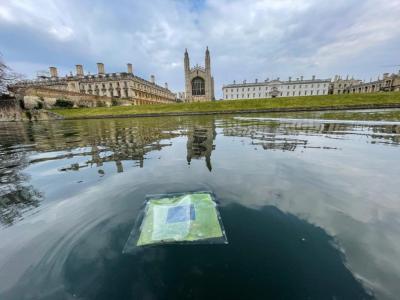University of Cambridge scientists have developed perovskite-based floating ‘artificial leaves’ that generate clean fuels from sunlight and water. The team expects these could eventually operate on a large scale at sea. The ultra-thin flexible devices take their inspiration from photosynthesis. Since the low-cost, autonomous devices are light enough to float, they could be used to generate a sustainable alternative to gasoline without taking up space on land.
A floating artificial leaf which can generate clean fuel from sunlight and water – on the River Cam near King’s College Chapel in Cambridge, UK. Image credit: Virgil Andrei, from: Scitechdaily
Outdoor tests of the lightweight leaves on the River Cam showed that they can convert sunlight into fuels as efficiently as plant leaves. River Cam is the main river flowing through Cambridge in eastern England, and the testing occurred near iconic Cambridge sites including the Bridge of Sighs, the Wren Library, and King’s College Chapel.
This is reported as 'the first time that clean fuel has been generated on water'. If it were scaled up, the artificial leaves could be used on polluted waterways, in ports, or even at sea, and could help reduce the global shipping industry’s reliance on fossil fuels.
For several years, Professor Erwin Reisner’s research group in Cambridge has been working to develop sustainable solutions to gasoline that are based on the principles of photosynthesis. In 2019, they developed an artificial leaf, which makes syngas from sunlight, carbon dioxide, and water. Syngas is a key intermediate in the production of many chemicals and pharmaceuticals. The earlier prototype produced fuel by combining two light absorbers with suitable catalysts. However, it incorporated thick glass substrates and moisture-protective coatings, which made the device bulky.
“Artificial leaves could substantially lower the cost of sustainable fuel production, but since they’re both heavy and fragile, they’re difficult to produce at scale and transport,” said Dr. Virgil Andrei from Cambridge’s Yusuf Hamied Department of Chemistry, the paper’s co-lead author.
“We wanted to see how far we can trim down the materials these devices use, while not affecting their performance,” said Reisner, who led the research. “If we can trim the materials down far enough that they’re light enough to float, then it opens up whole new ways that these artificial leaves could be used.”
The challenge for the Cambridge research team was how to deposit light absorbers onto lightweight substrates and protect them against water infiltration. To overcome these challenges, the researchers used thin-film metal oxides and perovskites, which can be coated onto flexible plastic and metal foils. The devices were covered with micrometer-thin, water-repellent carbon-based layers that prevented moisture degradation. The result was a device that not only works, but also resembles a real leaf.
“This study demonstrates that artificial leaves are compatible with modern fabrication techniques, representing an early step towards the automation and up-scaling of solar fuel production,” said Andrei. “These leaves combine the advantages of most solar fuel technologies, as they achieve the low weight of powder suspensions and the high performance of wired systems.”
Tests of the new artificial leaves demonstrated that they can split water into hydrogen and oxygen, or reduce CO2 to syngas. While additional improvements will need to be made before they are ready for commercial applications, the scientists say this development opens whole new avenues in their work.
“Solar farms have become popular for electricity production; we envision similar farms for fuel synthesis,” said Andrei. “These could supply coastal settlements, remote islands, cover industrial ponds, or avoid water evaporation from irrigation canals.”
“Many renewable energy technologies, including solar fuel technologies, can take up large amounts of space on land, so moving production to open water would mean that clean energy and land use aren’t competing with one another,” said Reisner. “In theory, you could roll up these devices and put them almost anywhere, in almost any country, which would also help with energy security.”


